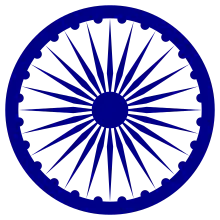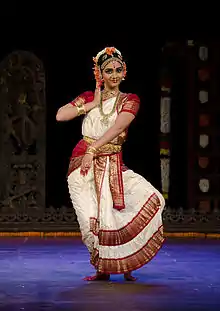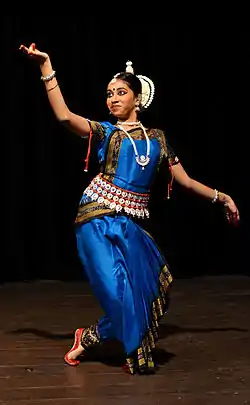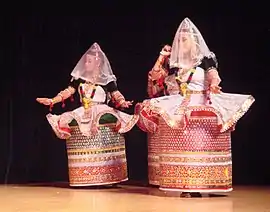Indian classical dance
Indian classical dance or 'Shastriya Devesh' is an umbrella term for various performance arts rooted in religious Hindu musical theatre styles,[1][2][3] whose theory and practice can be traced to the Sanskrit text Natya Shastra.[4][5][6]
| Part of a series on the |
| Culture of India |
|---|
 |
| History |
| People |
| Cuisine |
| Religion |
| Sport |
|
The number of recognised classical dances range from eight to more, depending on the source and scholar.[7] The Sangeet Natak Academy recognizes eight – Bharatanatyam, Kathak, Kuchipudi, Odissi, Kathakali, Sattriya, Manipuri and Mohiniyattam.[8] Scholars such as Drid Williams add Chhau, Yakshagana and Bhagavata Mela to the list.[9][3] Additionally, the Indian Ministry of Culture includes Chhau in its classical list. These dances are traditionally regional, all of them include music and recitation in local language or Sanskrit, and they represent a unity of core ideas in a diversity of styles, costumes and expression. At present officially there are 9 classical dances in India.
Types of classical dances
The Natya Shastra is the foundational treatise for classical dances of India,[4][10] and this text is attributed to the ancient scholar Bharata Muni.[6][11][12] Its first complete compilation is dated to between 200 BCE and 200 CE,[13][14] but estimates vary between 500 BCE and 500 CE.[15] The most studied version of the Natya Shastra text consists of about 6000 verses structured into 36 chapters.[13][16] The text, states Natalia Lidova, describes the theory of Tāṇḍava dance (Shiva), the theory of rasa, of bhāva, expression, gestures, acting techniques, basic steps, standing postures – all of which are part of Indian classical dances.[13][17] Dance and performance arts, states this ancient text, are a form of expression of spiritual ideas, virtues and the essence of scriptures.[18][19]
Let Nātya (drama and dance) be the fifth vedic scripture.
Combined with an epic story,
tending to virtue, wealth, joy and spiritual freedom,
it must contain the significance of every scripture,
and forward every art.
While the Natya Shastra is the revered ancient text in the Hindu tradition, there are numerous other ancient and medieval Sanskrit dance-drama related texts that further discuss and expand on the classical repertoire of performance arts, such as the Abhinaya Darpana, Abhinava Bharati, Natya Darpana, Bhava Prakasa and many others.[21][22][23] The term "classical" (Sanskrit: "Shastriya") denotes the ancient Indian Shastra-based performing arts.
The text Natya Shastra describes religious arts as a form as margi, or a "spiritual traditional path" that liberates the soul, while the folk entertainment is called desi, or a "regional popular practice".[24][25][26]
Indian classical dances are traditionally performed as an expressive drama-dance form of religious performance art,[3] related to Vaishnavism, Shaivism, Shaktism, pan-Hindu Epics and the Vedic literature, or a folksy entertainment that includes story-telling from Sanskrit or regional language plays.[27] As a religious art, they are either performed inside the sanctum of a Hindu temple, or near it.[1][2] Folksy entertainment may also be performed in temple grounds or any fairground, typically in a rural setting by travelling troupes of artists; alternatively, they have been performed inside the halls of royal courts or public squares during festivals.[28]
Dance forms
The Natya Shastra mentions four Pravrittis (traditions, genres) of ancient dance-drama in vogue when it was composed – Avanti (Ujjain, central), Dakshinatya (south), Panchali (north, west) and Odra-Magadhi (east).[29]
Sources differ in their list of Indian classical dance forms.[30][31] Encyclopædia Britannica mentions six dances.[32] The Sangeet Natak Akademi has given recognition to nine Indian dances.[33] The Indian government's Ministry of Culture includes eleven dance forms.[34] Scholars such as Drid Williams and others include Chhau, Yaksagana and Bhagavata Mela to the eight classical Indian dances in the Sangeet Natak Akademi list.[3][9]
The classical dance forms recognised by the Sangeet Natak Akademi and the Ministry of Culture are:[33][35]
- Bharatanatyam, from Tamil Nadu
- Kathak, from Uttar Pradesh
- Kathakali, from Kerala
- Kuchipudi, from Andhra Pradesh
- Odissi, from Odisha
- Sattriya, from Assam
- Manipuri, from Manipur
- Mohiniyattam, from Kerala
Famous Dancers of Indian Classical Dance Forms
There have been many famous dancers in each Indian classical Dance form. Some of them include;
- Bharatanatyam - Rukmini Devi, Padma Subrahmanyam, Vyjayanthimala, Sheema Kermani
- Kathak - Birju Maharaj, Nahid Siddiqui, Sambhu Maharaj, Lacchu Maharaj, Gopi Krishna etc.[36]
- Kathakali - Kalamandalam, Krishnan Nair, Ramanakutty Nair, etc.
- Kuchipudi - Mallika Sarabhai, V. Satyanarayana Sarma, Deepa Shashindran, etc.
- Odissi - Sujatha Mohapatra, Madhavi Mudgal
Shared aspects
All major classical Indian dance forms include in repertoire, three categories of performance in the Natya Shastra. These are Nritta, Nritya and Natya:[37]
- The Nritta performance is an abstract, fast and rhythmic aspect of the dance.[38] The viewer is presented with pure movement, wherein the emphasis is the beauty in motion, form, speed, range and pattern.[37] This part of the repertoire has no interpretative aspect, no telling of the story. It is a technical performance, and aims to engage the senses (Prakriti) of the audience.[39]
- The Nritya is slower and expressive aspect of the dance that attempts to communicate feelings, storyline particularly with spiritual themes in Hindu dance traditions.[38] In a Nritya, the dance-acting expands to include silent expression of words through gestures and body motion set to musical notes. The actor articulates a legend or a spiritual message. This part of the repertoire is more than sensory enjoyment, it aims to engage the emotions and mind of the viewer.[37][39]
- The Natyam is a play, typically a team performance,[40] but can be acted out by a solo performer where the dancer uses certain standardized body movements to indicate a new character in the underlying story. A Natya incorporates the elements of a Nritya.[37][41][42]
All classical dances of India used similar symbolism and rules of gestures in abhinaya (acting). The roots of abhinaya are found in the Natyashastra text which defines drama in verse 6.10 as that which aesthetically arouses joy in the spectator, through the medium of actor's art of communication, that helps connect and transport the individual into a super sensual inner state of being.[43] A performance art, asserts Natyashastra, connects the artists and the audience through abhinaya (literally, "carrying to the spectators"), that is applying body-speech-mind and scene, wherein the actors communicate to the audience, through song and music.[43] Drama in this ancient Sanskrit text, this is an art to engage every aspect of life, to glorify and gift a state of joyful consciousness.[44]
The communication through symbols is in the form of expressive gestures (mudras or hastas) and pantomime set to music. The gestures and facial expressions convey the ras (sentiment, emotional taste) and bhava (mood) of the underlying story.[45] In Hindu classical dances, the artist successfully expresses the spiritual ideas by paying attention to four aspects of a performance:
- Angika (gestures and body language),
- Vachika (song, recitation, music and rhythm),
- Aharya (stage setting, costume, make up, jewelry),
- Sattvika (artist's mental disposition and emotional connection with the story and audience, wherein the artist's inner and outer state resonates).[45]
- Abhinaya draws out the bhava (mood, psychological states).[45]
See also
| Performing arts |
|---|
References
- Julius Lipner (2012). Hindus: Their Religious Beliefs and Practices. Routledge. p. 206. ISBN 978-1-135-24061-5., Quote: "It would be appropriate here to comment on Hindu classical dance. This developed in a religious context and was given high profile as part of temple worship. There are several regional and other styles as well as source texts, but the point we wish to stress is the participative nature of such dance. In form and content, the heart of dance as worship in Hinduism has always been 'expression' (abhinaya), i.e. the enacting of various themes".
- Jean Holm; John Bowker (1994). Worship. Bloomsbury Academic. p. 85. ISBN 978-1-85567-111-9., Quote: Hindu classical dance-forms, like Hindu music, are associated with worship. References to dance and music are found in the Vedic literature, (...)".
- Frank Burch Brown (2013). The Oxford Handbook of Religion and the Arts. Oxford University Press. pp. 195–196. ISBN 978-0-19-972103-0., Quote: All of the dances considered to be part of the Indian classical canon (Bharata Natyam, Chhau, Kathak, Kathakali, Kuchipudi, Manipuri, Mohiniattam, Odissi, Sattriya, and Yakshagana) trace their roots to religious practices (...) the Indian diaspora has led to the translocation of Hindu dances to Europe, North America and the world."
- James G. Lochtefeld (2002). The Illustrated Encyclopedia of Hinduism: N-Z. The Rosen Publishing Group. pp. 467. ISBN 978-0-8239-3180-4., Quote: "the Natyashastra remains the ultimate authority for any dance form that claims to be 'classical' dance, rather than 'folk' dance".
- Ragini Devi 1990, pp. 60-68.
- Mohan Khokar (1984). Traditions of Indian classical dance. Clarion Books. pp. 57–58.
- Sarwal, Amit; Walker, David (2015). "Staging a Cultural Collaboration: Louise Lightfoot and Ananda Shivaram". Dance Chronicle. 38 (3): 305–335. doi:10.1080/01472526.2015.1088286.
- Bishnupriya Dutt; Urmimala Sarkar Munsi (2010). Engendering Performance: Indian Women Performers in Search of an Identity. SAGE Publications. p. 216. ISBN 978-81-321-0612-8.
- Williams 2004, pp. 83-84, the other major classical Indian dances are: Bharatanatyam, Kathak, Odissi, Kathakali, Kuchipudi, Sattriya, Cchau, Manipuri, Yaksagana and Bhagavata Mela.
- Tanvi Bajaj; Swasti Shrimali Vohra (2015). Performing Arts and Therapeutic Implications. Routledge. pp. 6–7. ISBN 978-1-317-32572-7.
- Schramm, Harold (1968). "Musical Theatre in India". Asian Music. University of Texas Press. 1 (1): 31–40. doi:10.2307/834008. JSTOR 834008.
- Coorlawala, Uttara Asha (1993). "The Toronto conference on "new directions in Indian dance"". Dance Chronicle. Routledge. 16 (3): 391–396. doi:10.1080/01472529308569140.
- Natalia Lidova 2014.
- Tarla Mehta 1995, pp. xxiv, 19–20.
- Wallace Dace 1963, p. 249.
- Emmie Te Nijenhuis 1974, pp. 1–25.
- Kapila Vatsyayan 2001.
- Coormaraswamy and Duggirala (1917). "The Mirror of Gesture". Harvard University Press. p. 4.; Also see chapter 36
- Guy L. Beck (2012). Sonic Liturgy: Ritual and Music in Hindu Tradition. University of South Carolina Press. pp. 138–139. ISBN 978-1-61117-108-2.
Quote: "A summation of the signal importance of the Natyasastra for Hindu religion and culture has been provided by Susan Schwartz, "In short, the Natyasastra is an exhaustive encyclopedic dissertation of the arts, with an emphasis on performing arts as its central feature. It is also full of invocations to deities, acknowledging the divine origins of the arts and the central role of performance arts in achieving divine goals (...)".
- "Natyashastra" (PDF). Sanskrit Documents.
- Tarla Mehta 1995, pp. xxix, 131-137.
- Mandakranta Bose (2012). Movement and Mimesis: The Idea of Dance in the Sanskritic Tradition. Springer. pp. 13–32, 108–112. ISBN 978-94-011-3594-8.
- Ragini Devi 1990, pp. 18-37.
- Reginald Massey 2004, p. 32.
- Ragini Devi 1990, pp. 67, context: 60-68.
- Thera Mahanama-sthavira (1999). Mahavamsa: The Great Chronicle of Sri Lanka. Jain Publishing. pp. 40–41. ISBN 978-0-89581-906-2.
- Ragini Devi 1990, pp. 25-30, 67-68, 166.
- Farley P. Richmond, Darius L. Swann & Phillip B. Zarrilli 1993, pp. 3, 34-36, 47, 171-173, 215, 327-329.
- Sunil Kothari; Avinash Pasricha (1990). Odissi, Indian classical dance art. Marg Publications. pp. 5–6. ISBN 978-81-85026-13-8.
- "Indian Classical Dance". One India. 2009-04-19. Archived from the original on 2009-04-17. Retrieved 2010-06-11.
- Narayan, Shovana (2005). Indian classical dances: "ekam sat vipraah bahudaa vadanti". Shubhi Publications. p. 5. ISBN 9781845571696.
- Encyclopædia Britannica. dance (performing arts) : Indian classical dance. Retrieved 03-11-2010.
- SNA || Awards & Honours
- "Scholarship to Young Artistes". Indiaculture.nic.in. Archived from the original on 2013-10-21. Retrieved 2013-11-06.
- Dance | Ministry of Culture, Government of India
- "Indian Classical Dance Forms". PendulumEdu. PendulumEdu. Retrieved 1 December 2020.
- Meduri, Avanthi (1988). "Bharatha Natyam-What Are You?". Asian Theatre Journal. University of Hawaii Press. 5 (1): 3–4. doi:10.2307/1124019. JSTOR 1124019.
- Ellen Koskoff (2008). The Concise Garland Encyclopedia of World Music: The Middle East, South Asia, East Asia, Southeast Asia. Routledge. p. 955. ISBN 978-0-415-99404-0.
- Janet Descutner (2010). Asian Dance. Infobase. pp. 45–46. ISBN 978-1-4381-3078-1.
- Kavitha Jayakrishnan (2011), Dancing Architecture: the parallel evolution of Bharatanātyam and South Indian Architecture, MA Thesis, Awarded by University of Waterloo, Canada, page 25
- Reginald Massey 2004, pp. 33-38, 83-84, 207-214.
- Bruno Nettl; Ruth M. Stone; James Porter; et al. (1998). The Garland Encyclopedia of World Music: South Asia : the Indian subcontinent. Routledge. pp. 516–521. ISBN 978-0-8240-4946-1.
- Tarla Mehta 1995, p. 3.
- Tarla Mehta 1995, p. 5.
- Tanvi Bajaj; Swasti Shrimali Vohra (2015). Performing Arts and Therapeutic Implications. Routledge. pp. 82–84. ISBN 978-1-317-32572-7.
Bibliography
- Ambrose, Kay (1984). Classical Dances and Love of India. Palgrave Macmillan.
- Ragini Devi (1990). Dance Dialects of India. Motilal Banarsidass. ISBN 978-81-208-0674-0.
- Natalia Lidova (2014). "Natyashastra". Oxford University Press. doi:10.1093/obo/9780195399318-0071.
- Natalia Lidova (1994). Drama and Ritual of Early Hinduism. Motilal Banarsidass. ISBN 978-81-208-1234-5.
- Williams, Drid (2004). "In the Shadow of Hollywood Orientalism: Authentic East Indian Dancing" (PDF). Visual Anthropology. Routledge. 17 (1): 69–98. doi:10.1080/08949460490274013.
- Tarla Mehta (1995). Sanskrit Play Production in Ancient India. Motilal Banarsidass. ISBN 978-81-208-1057-0.
- Reginald Massey (2004). India's Dances: Their History, Technique, and Repertoire. Abhinav Publications. ISBN 978-81-7017-434-9.
- Emmie Te Nijenhuis (1974). Indian Music: History and Structure. BRILL Academic. ISBN 90-04-03978-3.
- Kapila Vatsyayan (2001). Bharata, the Nāṭyaśāstra. Sahitya Akademi. ISBN 978-81-260-1220-6.
- Kapila Vatsyayan (1977). Classical Indian dance in literature and the arts. Sangeet Natak Akademi. OCLC 233639306., Table of Contents
- Kapila Vatsyayan (1974). Indian classical dance. Sangeet Natak Akademi. OCLC 2238067.
- Kapila Vatsyayan (2008). Aesthetic theories and forms in Indian tradition. Munshiram Manoharlal. ISBN 978-8187586357. OCLC 286469807.
- Kapila Vatsyayan. Dance In Indian Painting. Abhinav Publications. ISBN 978-81-7017-153-9.
- Wallace Dace (1963). "The Concept of "Rasa" in Sanskrit Dramatic Theory". Educational Theatre Journal. 15 (3): 249–254. doi:10.2307/3204783. JSTOR 3204783.
- Farley P. Richmond; Darius L. Swann; Phillip B. Zarrilli (1993). Indian Theatre: Traditions of Performance. Motilal Banarsidass. ISBN 978-81-208-0981-9.
- Revealing the Art of Natyasastra by Narayanan Chittoor Namboodiripad ISBN 9788121512183
- "Andhra Pradesh Portal: Dance". Andhra Pradesh Government. Archived from the original on 2010-12-04. Retrieved 2010-11-03.








